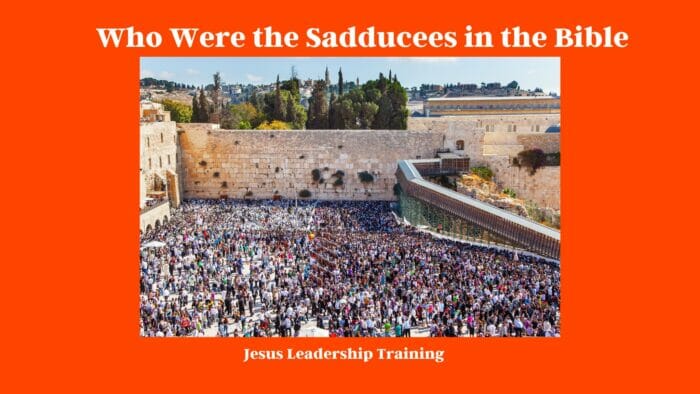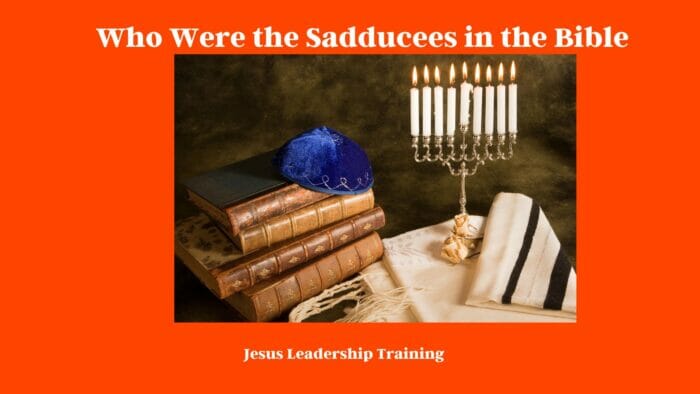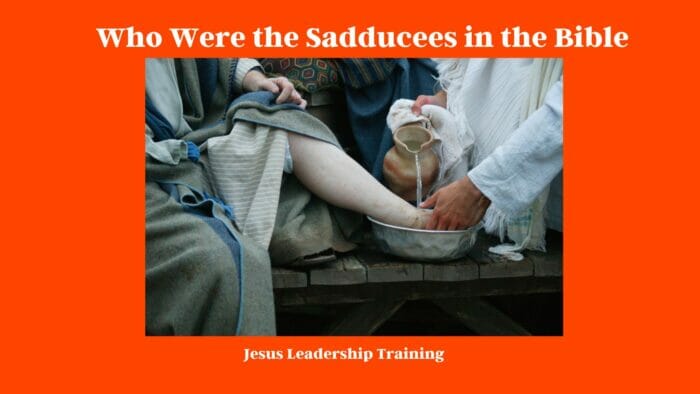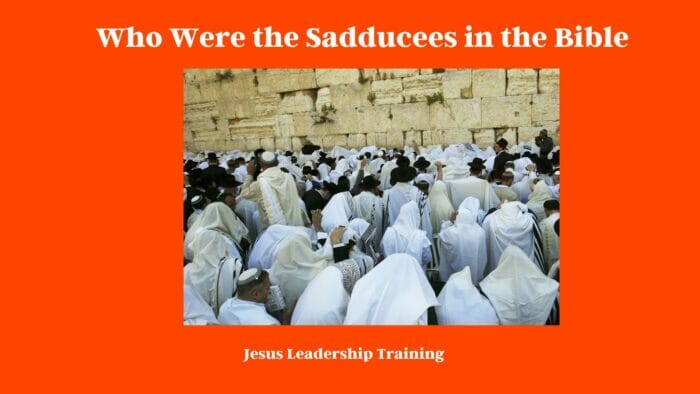Who Were the Sadducees in the Bible – n the bustling arena of biblical history, numerous intriguing figures and groups come to life. One of these fascinating entities is the Sadducees, an ancient Jewish sect that held a prominent place during the Hellenistic and Roman periods. So, who were the Sadducees in the Bible? Buckle up as we’re about to embark on an exciting journey, peeling back the layers of time and bringing the enigmatic Sadducees into the spotlight.
Table of Contents
Who Were the Sadducees in the Bible
Origins of the Sadducees
The story of the Sadducees starts in the tumultuous period of the Hellenistic age, around the second century BCE. Their name likely derived from Zadok, the high priest during the reign of King David and Solomon. However, the Sadducees as a sect didn’t gain their footing until the Hasmonean dynasty, when the sect likely came into its own.
Beliefs and Doctrines of the Sadducees
To appreciate fully who were the Sadducees in the Bible, it’s essential to dive into their beliefs. The Sadducees held distinct doctrines, contrasting them with other Jewish sects like the Pharisees. For one, they rejected the Oral Torah, focusing instead solely on the Written Torah, the first five books of the Bible. Secondly, they didn’t believe in the resurrection of the dead, a cornerstone of early Christian theology.

The Sadducees were a sect within Judaism during the Second Temple period (516 BCE – 70 CE), which overlaps with the time period of the New Testament. They were often at odds with another sect known as the Pharisees. Here is a table outlining some of their main faith beliefs according to historical accounts, primarily those of Josephus and the New Testament:
| Belief | Description |
|---|---|
| Torah Primacy | The Sadducees held that only the written Torah (the first five books of the Bible) was authoritative. In contrast to the Pharisees, they rejected the Oral Torah and rabbinic traditions. |
| Afterlife Denial | They did not believe in the resurrection of the dead, an afterlife, or the existence of a spiritual soul. This was in stark contrast with the Pharisees and early Christian followers who did believe in resurrection. |
| Angels and Spirits | The Sadducees denied the existence of angels and spirits, another point of contention with the Pharisees and early Christians. |
| Free Will | They believed in the absolute free will of people and rejected the notion of predestination or determinism. They asserted that God does not punish or reward people for their actions. |
| Temple Rituals | As a largely priestly and aristocratic group, they were heavily involved in the operations of the Temple in Jerusalem and focused on the proper performance of Temple rituals. |
| Political Cooperation with Rome | The Sadducees were more likely to cooperate with the Roman authorities and were therefore often seen as more politically accommodating than the Pharisees. |
It’s important to note that our understanding of the Sadducees is limited and subject to interpretation, as the primary sources about them come from their opponents, like the Pharisees and early Christians.

Sadducees in Society
The Sadducees held a significant societal position. Predominantly aristocratic and priestly, they managed the Temple in Jerusalem and had substantial political influence. Their societal standing often brought them into conflict with other Jewish sects, notably the Pharisees.
The Sadducees in Biblical Texts
The Sadducees in the Old Testament
Curiously, the Old Testament doesn’t explicitly mention the Sadducees. Their roots trace back to the Zadokite priests, but as a distinct group, they don’t appear. The silence of the Old Testament regarding the Sadducees is likely due to their emergence after the Old Testament was compiled.
The Sadducees in the New Testament (Jesus)
The New Testament, on the other hand, portrays the Sadducees frequently. They are often depicted in opposition to Jesus Christ. For instance, in the Book of Matthew, Sadducees challenge Jesus over the resurrection of the dead, reflecting their doctrinal differences.

Significant Sadducees Figures
Annas and Caiaphas: High Priests and Sadducees (Temple)
Two of the most notable Sadducees were Annas and his son-in-law Caiaphas, both serving as high priests. Caiaphas, in particular, played a pivotal role in the trial and crucifixion of Jesus, as detailed in the New Testament.
The Hasmoneans: Sadducee Rulers (People)
The Hasmonean dynasty, a line of rulers from the Maccabees, were likely affiliated with the Sadducees. Their rule marked a period of Sadducee influence, despite ongoing conflicts with the Pharisees.
The Sadducees and Other Jewish Sects
Sadducees vs. Pharisees (Faith)
A major dichotomy in the Jewish society of the Second Temple period was the one between Sadducees
and Pharisees. They often clashed on doctrinal matters. For instance, the Pharisees embraced the Oral Torah and the belief in the afterlife, both rejected by the Sadducees.
The Sadducees and the Pharisees were two distinct sects of Judaism that emerged during the Second Temple period. While both believed in Jewish Law, they interpreted and applied it differently. Here is a table outlining some of the primary differences in their faith beliefs, according to historical accounts, including those in the New Testament:
| Beliefs | Sadducees | Pharisees |
|---|---|---|
| Authority of Scriptures | They held only the Torah (the first five books of the Bible) as authoritative. | They believed in the entire Hebrew Bible (Torah, Prophets, and Writings) and also revered the Oral Torah and rabbinic traditions. |
| Afterlife | Denied the existence of an afterlife and the resurrection of the dead. | Affirmed the existence of an afterlife and the resurrection of the dead. |
| Angels and Spirits | Denied the existence of angels and spirits. | Believed in the existence of angels and spirits. |
| Predestination vs Free Will | Believed in absolute free will and rejected predestination. | Believed in a mix of free will and divine predestination. |
| Temple Rituals | As a largely priestly and aristocratic group, they emphasized Temple rituals. | They focused on applying Jewish Law to everyday life and promoted synagogue and personal prayer, alongside Temple rituals. |
| Cooperation with Rome | Were more willing to cooperate with Roman authorities. | Generally opposed Roman rule and often advocated for Jewish autonomy. |
As always, it’s important to remember that our understanding of these groups is limited, and the above distinctions may not reflect the full complexity and diversity within these groups. Both the Sadducees and the Pharisees consisted of various sub-sects with differing views.
Sadducees and the Essenes
Another Jewish sect, the Essenes, were contemporaries of the Sadducees. They were ascetics, shunning the luxury embraced by the Sadducee aristocracy, and held mystical beliefs, making for another stark contrast with the Sadducean ideology.
The Sadducees, Pharisees, and Essenes were three distinct sects of Judaism that emerged during the Second Temple period. Each had its unique interpretations and applications of Jewish Law. Below is a table outlining some of the primary differences in faith beliefs between the Sadducees and the Essenes, according to historical accounts, including those in the Dead Sea Scrolls:
| Beliefs | Sadducees | Essenes |
|---|---|---|
| Authority of Scriptures | Held only the Torah (the first five books of the Bible) as authoritative. | Believed in the authority of the entire Hebrew Bible and also respected other religious texts such as the Book of Enoch. |
| Afterlife | Denied the existence of an afterlife and the resurrection of the dead. | Believed in the immortality of the soul and the judgement in the afterlife. |
| Angels and Spirits | Denied the existence of angels and spirits. | Believed in the existence of angels and spirits. |
| Lifestyle | Primarily a wealthy, aristocratic group involved in temple leadership. | Practiced a communal lifestyle and focused on purity, including ritual bathing. Many lived in isolated communities, like Qumran. |
| Temple Rituals | As a priestly group, they emphasized Temple rituals. | Criticized the Temple practices and priesthood of their time. Developed an alternate form of worship, focusing on study and purity. |
| Cooperation with Rome | More willing to cooperate with Roman authorities. | Generally lived in seclusion, having little to do with Rome or even mainstream Jewish society. |
As with all ancient groups, our understanding of the Essenes and Sadducees is limited, and these distinctions may not capture the full complexity and diversity within each sect.
The Sadducees were a significant group in Judea during the Second Temple period, primarily known for their connections to the Temple in Jerusalem and its administration. However, pinning down exact dates for their origin and demise is somewhat challenging because the historical record is not entirely precise. The following timetable presents an approximate outline based on historical and Biblical accounts:
| Event | Date | Details |
|---|---|---|
| Origination of the Sadducees | 2nd Century BCE | The precise origin of the Sadducees is not clear, but it’s generally believed they emerged as a distinct group around the 2nd century BCE, during the Hasmonean Dynasty. The name “Sadducee” possibly comes from “Zadok,” the High Priest during King David’s and King Solomon’s reign, indicating a claim to priestly lineage and authority. |
| Peak Influence | 1st Century BCE to 1st Century CE | The Sadducees held significant power in Jerusalem during this period, controlling the Sanhedrin (Jewish high court) and the Temple’s administration. They were the dominant political and religious force before and during Jesus’s time. |
| Demise of the Sadducees | 70 CE | The destruction of the Second Temple in Jerusalem by the Romans in 70 CE marked the end of the Sadducees’ central place of power and influence. After this point, they largely disappeared from historical records. The Pharisees, who had a more decentralized structure and focus on law and synagogue, went on to shape what would become Rabbinic Judaism. |
This timeline provides a general overview. Please note that specifics, such as exact dates and comprehensive details of the Sadducees’ beliefs and activities, are often subject to scholarly debate due to limited historical sources.
The End of the Sadducees
The fall of Jerusalem in 70 CE and the destruction of the Second Temple marked the end of the Sadducees. Their close association with the temple and its rituals meant that when the temple fell, so did they. Their beliefs and practices didn’t survive, and they faded into history, leaving only traces in ancient texts for us to piece together who were the Sadducees in the Bible.
FAQs
- When did the Sadducees emerge?
The Sadducees emerged around the second century BCE, during the Hasmonean dynasty. - What were the central beliefs of the Sadducees?
The Sadducees upheld the Written Torah and rejected the Oral Torah. They also didn’t believe in the resurrection of the dead or an afterlife. - What was the societal role of the Sadducees?
The Sadducees were primarily from aristocratic and priestly classes. They managed the Temple in Jerusalem and wielded significant political influence. - Are there any significant Sadducee figures in the Bible?
Yes, Annas and Caiaphas, both high priests, and likely the Hasmonean rulers, are notable figures associated with the Sadducees. - What happened to the Sadducees?
The Sadducees faded into obscurity following the destruction of the Second Temple in 70 CE. - How did the Sadducees differ from the Pharisees and Essenes?
The Sadducees rejected the Oral Torah and belief in the afterlife, unlike the Pharisees. They were also less ascetic and more aristocratic than the Essenes.
Final Thoughts – Who Were the Sadducees in the Bible
Understanding who were the Sadducees in the Bible is a journey into the heart of religious, social, and political life in the Second Temple period of Jewish history. Though they faded away, their legacy endures in biblical texts, serving as a lens into the rich tapestry of beliefs and conflicts of that era. The Sadducees remind us of the multifaceted nature of history and the myriad ways it shapes the world we inhabit today.
Best Old Testament Commentaries
Below is a table featuring some renowned Old Testament commentaries, their publishers, and websites where they can be found. As always, it’s best to confirm availability on multiple platforms or the publishers’ websites.
| Commentary Name | Publisher | Website |
|---|---|---|
| The New International Commentary on the Old Testament | Eerdmans | Eerdmans |
| Word Biblical Commentary | Zondervan | Zondervan |
| Baker Commentary on the Old Testament | Baker Academic | Baker Academic |
| The Anchor Yale Bible Commentary | Yale University Press | Yale University Press |
| Tyndale Old Testament Commentaries | InterVarsity Press | InterVarsity Press |
| Expositor’s Bible Commentary | Zondervan | Zondervan |
| The Old Testament for Everyone | Westminster John Knox Press | Westminster John Knox Press |
Note: As with the New Testament table, this table provides generalized examples and does not list each volume within the commentary series. The commentaries can usually be found on the publishers’ websites or other online book retailers such as Amazon or Christianbook. It is always advisable to check for the most accurate and up-to-date information regarding availability.




